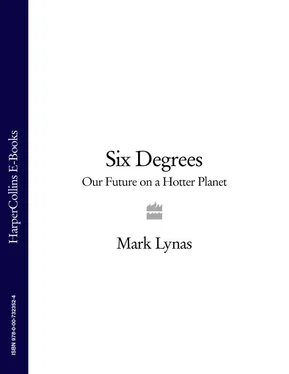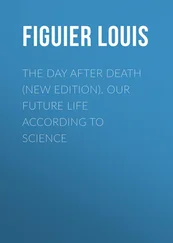As the work emerged, I felt a nagging suspicion that maybe I should be keeping it all secret. Six Degrees was beginning to feel like a survival manual, full of indications about which parts of the globe might need to be abandoned, and which would be most likely to remain habitable. Maybe I should be sharing this information only with my family and friends, to give those people closest to me a quiet heads-up? Or perhaps I should get it out as widely as possible, as a sort of cautionary tale, to convince people to campaign for rapid emissions cuts and avoid the worst-case scenarios before it is too late?
Obviously I chose the second, more optimistic course. But a related question continued to bug me as I did early public presentations of Six Degrees material, particularly when I overheard a conversation in the toilets after one event in which an audience member apologised to another for dragging them out to something so depressing. I was truly shocked. Depressing? It had honestly never occurred to me that Six Degrees might be depressing. Yes, the impacts presented are terrifying-but they are also, in the main, still avoidable. Getting depressed about the situation now is like sitting inert in your living room and watching the kitchen catch fire, and then getting more and more miserable as the fire spreads throughout the house-rather than grabbing an extinguisher and dousing the flames.
It also dawned on me gradually when I tried to explain the book to non-specialists that most ordinary people have not got the slightest idea what two, four or six degrees of average warming actually means in reality. These still sound like very small changes when the mercury swings by fifteen degrees between night and day. To most of us, if Thursday is six degrees warmer than Wednesday, it doesn't mean the end of the world, it means we can leave the overcoat at home. Such are the vagaries of everyday weather. But six degrees of global average change is an entirely different prospect.
Consider this: 18,000 years ago, during the deepest freeze of the last ice age, global temperatures were about six degrees colder than today. In that frigid climate, ice sheets stretched across North America from sea to shining sea. As glacial grooves in the rocks in Central Park attest, New York was buried under a thick slab of ice, more than a mile deep as it stretched into the heart of the continent. Northern New Jersey was buried, as was all the Great Lakes area, and almost the entirety of Canada. Further south, the agricultural heartland of states like Missouri and Iowa would have been freezing tundra, blasted by dust-laden winds sweeping down from the ice cap, and underlain by layers of solid permafrost. During the ice age, humans were displaced far to the south, where places that are now subtropical, like Florida and California, maintained a temperate climate.
In addition, temperature swings were astonishingly rapid-several degrees in the space of a decade as the climate warmed and then cooled again. At one point, about 70,000 years ago, a huge supervolcano eruption in Indonesia blew thousands of cubic kilometres of dust and sulphur into the atmosphere, cutting off the Sun's heat and causing global temperatures to plummet. Humans were nearly wiped out in the ensuing ‘nuclear’ winter: the entire global human population crashed to somewhere between 15,000 and 40,000 individuals, a survival bottleneck which is still written in the genes of every human alive today. By implication, if six degrees of cooling was enough to nearly wipe us out in the past, might six degrees of warming have a similar effect in the future? That is the question this book seeks to answer.
Back in the summer of 2005, as I began my journey into humanity's likely future, I felt like Dante at the gates of the Inferno-privileged to see what few others have laid eyes upon, but also deeply worried by the horrors that seemed to lie ahead. Just as the poet Virgil was Dante's guide as he set forth into the Inferno, my guides are the many talented and passionate scientists who conducted the original research studies on which this book is based. I offer them my thanks, and hope they feel well represented by what follows.
‘Set out then, for one will prompts us both.
You are my leader, you my lord and master,’
I said to him, and when he moved ahead
I entered on the deep and savage way.
A technical note
As befits the task of any popular science writer, I have tried to make each case study come alive as much as possible without losing the rigour of the original document. Where the science itself has evolved through the years, I have tried to work this into the story. There were drawbacks of course: almost all the studies use different models, each model employing different underlying assumptions, so comparing them can sometimes be rather like comparing chalk and cheese. Each study also contains uncertainties, often expressed in quantitative terms-such is the nature of good science-and carefully weighed, thoughtful statements by the authors which cannot always be accurately reflected in a broad-brush, generalist approach such as this. I leave readers with queries about any of the information presented to follow up references and judge the original work for themselves. Do not complain to me either if you have doubts about the methodologies employed by the original studies: I am not a climatologist, I am merely the interpreter.
I might also add at this point, for the benefit of any readers who feel somewhat out of depth with the generally ‘scienticised’ nature of the climate change debate, a very general note of background on global warming. Essentially, this term (which I use interchangeably with ‘climate change’, although technically they do mean slightly different things) refers to the increase in global atmospheric temperatures as a result of increasing concentrations of greenhouse gases in the air around us. That greenhouse gases have a warming effect, rather like an extra blanket around the globe, is indisputable, and has been established physics for over a hundred years. These gases cause a ‘greenhouse effect’ because they are opaque to long-wave infrared radiation: heat coming in from the Sun is short-wave, and so passes straight through, but when this heat is re-radiated by the Earth, its wavelength is longer, and some is trapped by the gases-just as glass in a greenhouse also traps heat. If there were no greenhouse gases at all in the atmosphere, the Earth's average temperature would be about —18°C.
Since the beginning of the Industrial Revolution, concentrations of the principal greenhouse gas, carbon dioxide (CO 2), have risen by a third, whilst those of methane-another potent greenhouse gas-have doubled. Although there have been fluctuations between the decades, global temperatures have also risen in the last 150 years by about 0.8°C, and are expected to rise even faster over the next century as CO 2levels rise further still. Partly these future temperature rises will be the result of emissions already in the past, and partly they will reflect rapid expected rises in greenhouse gas emissions from human activity. That we can avoid higher temperature increases by cutting back emissions is a key point that I seek to illustrate in this book.
Although I have done my best to ensure that the correct impact studies are presented in the correct chapters, there are occasions when the decision about what to put where is somewhat arbitrary. Many-most, in fact-papers do not state the precise global average temperature change that their study refers to, particularly if they are focusing on a regional change. A study on Arctic sea ice, for example, may be based on a range of different future carbon dioxide concentrations, none of which are interpreted as global temperature averages by the authors, leaving me with the difficult choice of estimating which chapter is the best fit. Different studies using the same future CO 2concentrations do not necessarily share the same temperature projections, moreover: all models have different ‘sensitivities’ to atmospheric greenhouse gas increases, further complicating the procedure. It is important to emphasise, however, that all of the material in this book comes from the peer-reviewed scientific literature-at no point do I base predictions on less reliable sources like newspaper articles or campaign group press releases.
Читать дальше












